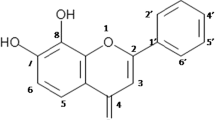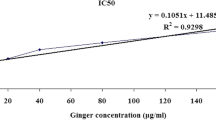Abstract
Alcohol consumption for a longer period of time is linked with neuronal damage and an increase in inflammatory signaling resulting in cell death and dementia. Natural compounds are the focus of research due to their high efficacy and good safety profile. Here we have investigated the effect of chronic epigallocatechin-3-gallate (EGCG) administration against the alcohol-induced cognitive deficit rats. Male Wistar rats were exposed to the 12% ethanol (10 g/kg; oral gavage) for ten weeks and treated with EGCG (25, 50, and 100 mg/kg) for the same duration. Ethanol exposure led to the impaired spatial memory and learning in rats assessed using the Morris water maze and elevated plus-maze test. Further, we assessed the role of EGCG in mitigating the oxidative stress, neuroinflammatory and cell death signaling associated markers. Co-administration with EGCG significantly prevented all the behavioral, biochemical and molecular alterations in the different brain regions of ethanol-treated rats in a dose-dependent manner. EGCG suppressed the acetylcholinesterase activity, increased oxidative–nitrosative stress, cytokines (TNF-alpha and IL-1beta), NF-kappa β and caspase-3 levels in both the cortex and hippocampus of ethanol-treated rats. Our preliminary study demonstrated that EGCG improves the oxido-nitrosative stress, inflammation, and cell death signaling associated with ethanol-induced cognitive dysfunction. This suggests the potential role of EGCG in mitigating the cognitive deficits associated with chronic alcohol consumption.





Similar content being viewed by others
Data availability
The datasets generated during and/or analyzed during the current study are available from the corresponding author on reasonable request.
References
Aboulmaouahib S, Madkour A, Kaarouch I et al (2018) Impact of alcohol and cigarette smoking consumption in male fertility potential: looks at lipid peroxidation, enzymatic antioxidant activities and sperm DNA damage. Andrologia 50:e12926
Ahadi S, Zargari M, Khalatbary AR (2019) Assessment of the neuroprotective effects of (-)-epigallocatechin-3-gallate on spinal cord ischemia-reperfusion injury in rats. J Spinal Cord Med 66:1–8
Ahmad A, Ali T, Rehman SU, Kim MO (2019) Phytomedicine-based potent antioxidant, Fisetin protects CNS-Insult LPS-induced oxidative stress-mediated neurodegeneration and memory impairment. J Clin Med 8:850
Ambade A, Mandrekar P (2012) Oxidative stress and inflammation: essential partners in alcoholic liver disease. Int J Hepatol. https://doi.org/10.1155/2012/853175
Bhatia S, Drake DM, Miller L, Wells PG (2019) Oxidative stress and DNA damage in the mechanism of fetal alcohol spectrum disorders. Birth Defects Res 111:714–748
Butterfield DA, Boyd-Kimball D (2020) Mitochondrial oxidative and nitrosative stress and alzheimer disease. Antioxidants 9:818
Castillo-Carniglia A, Keyes KM, Hasin DS, Cerdá M (2019) Psychiatric comorbidities in alcohol use disorder. The Lancet Psychiatry 6:1068–1080
Claiborne A (2018) Catalase activity. In: Handbook methods for oxygen radical research
Crespi C, Galandra C, Manera M et al (2019) Executive impairment in Alcohol Use Disorder reflects structural changes in large-scale brain networks: a joint Independent Component Analysis on grey-matter and white-matter features. Front Psychol 10:2479
Crespi C, Galandra C, Canessa N et al (2020) Microstructural damage of white-matter tracts connecting large-scale networks is related to impaired executive profile in alcohol use disorder. NeuroImage Clin 25:102141
Crichton GE, Bryan J, Murphy KJ (2013) Dietary antioxidants, cognitive function and dementia-a systematic review. Plant Foods Hum Nutr 68:279–292
Dwivedi DK, Kumar D, Kwatra M et al (2018) Voluntary alcohol consumption exacerbated high fat diet-induced cognitive deficits by NF-κB-calpain dependent apoptotic cell death in rat hippocampus: ameliorative effect of melatonin. Biomed Pharmacother 108:1393–1403
Ellman GL, Courtney KD, Andres V, Featherstone RM (1961) A new and rapid colorimetric determination of acetylcholinesterase activity. Biochem Pharmacol. https://doi.org/10.1016/0006-2952(61)90145-9
Fan AZ, Chou SP, Zhang H et al (2019) Prevalence and correlates of past-year recovery from DSM-5 alcohol use disorder: results from National Epidemiologic Survey on Alcohol and Related Conditions-III. Alcohol Clin Exp Res 43:2406–2420
Fernandes J, Gupta GL (2019) N-Acetylcysteine attenuates neuroinflammation associated depressive behavior induced by chronic unpredictable mild stress in rat. Behav Brain Res 364:356–365
Fukai T, Ushio-Fukai M (2020) Cross-talk between NADPH oxidase and mitochondria: role in ros signaling and angiogenesis. Cells 9:1849
Gandhi S, Abramov AY (2012) Mechanism of oxidative stress in neurodegeneration. Oxid. Med. Cell. Longev
Gibula-Tarlowska E, Kotlinska JH (2020) Kissorphin improves spatial memory and cognitive flexibility impairment induced by ethanol treatment in the Barnes maze task in rats. Behav Pharmacol. https://doi.org/10.1097/FBP.0000000000000557
Girard M, Malauzat D, Nubukpo P (2019) Serum inflammatory molecules and markers of neuronal damage in alcohol-dependent subjects after withdrawal. World J Biol Psychiatry 20:76–90
Harper C (2007) The neurotoxicity of alcohol. Hum Exp Toxicol 26:251–257
He Q, Bao L, Zimering J et al (2015) The protective role of (−)-epigallocatechin-3-gallate in thrombin-induced neuronal cell apoptosis and JNK-MAPK activation. NeuroReport 26:416
Hernández JA, López-Sánchez RC, Rendón-Ramírez A (2016) Lipids and oxidative stress associated with ethanol-induced neurological damage. Oxid Med Cell Longev 6:66
Iliev A, Traykov V, Pradanov D et al (1999) Effect of the acetylcholinesterase inhibitor galanthamine on learning and memory in prolonged alcohol intake rat model of acetylcholine deficit. Methods Find Exp Clin Pharmacol 21:297–302
Islam MT (2017) Oxidative stress and mitochondrial dysfunction-linked neurodegenerative disorders. Neurol Res 39:73–82
Jollow D, Mitchell JR, Zampaglione N, Gillette JR (1974) Bromobenzene-induced liver necrosis. Protective role of glutathione and evidence for 3,4-bromobenzene oxide as the hepatotoxic metabolite. Pharmacology 11:151–169. https://doi.org/10.1159/000136485
Kono Y (1978) Generation of superoxide radical during autoxidation of hydroxylamine and an assay for superoxide dismutase. Arch Biochem Biophys. https://doi.org/10.1016/0003-9861(78)90479-4
Kuhad A, Bishnoi M, Tiwari V, Chopra K (2009) Suppression of NF-κβ signaling pathway by tocotrienol can prevent diabetes associated cognitive deficits. Pharmacol Biochem Behav. https://doi.org/10.1016/j.pbb.2008.12.012
Liu Y, Zhang Y, Zheng X et al (2018) Galantamine improves cognition, hippocampal inflammation, and synaptic plasticity impairments induced by lipopolysaccharide in mice. J Neuroinflamm 15:112
Mende MA (2019) Alcohol in the aging brain—the interplay between alcohol consumption, cognitive decline and the cardiovascular system. Front Neurosci 13:66
Montesinos J, Pascual M, Pla A et al (2015) TLR4 elimination prevents synaptic and myelin alterations and long-term cognitive dysfunctions in adolescent mice with intermittent ethanol treatment. Brain Behav Immun 45:233–244
Morris RGM, Garrud P, Rawlins JNP, O’Keefe J (1982) Place navigation impaired in rats with hippocampal lesions. Nature. https://doi.org/10.1038/297681a0
Nkpaa KW, Amadi BA, Wegwu MO, Farombi EO (2019) Ethanol increases manganese—induced spatial learning and memory deficits via oxidative/nitrosative stress induced p53 dependent/independent hippocampal apoptosis. Toxicology. https://doi.org/10.1016/j.tox.2019.03.001
Park D, Choi E-K, Cho T-H et al (2020) Human neural stem cells encoding ChAT gene restore cognitive function via acetylcholine synthesis, Aβ elimination, and neuroregeneration in APPswe/PS1dE9 mice. Int J Mol Sci 21:3958
Petrella C, Carito V, Carere C et al (2020) Oxidative stress inhibition by resveratrol in alcohol dependent mice. Nutrition 66:110783
Pyapali GK, Turner DA, Wilson WA, Swartzwelder HS (1999) Age and dose-dependent effects of ethanol on the induction of hippocampal long-term potentiation. Alcohol. https://doi.org/10.1016/S0741-8329(99)00021-X
Ramdial K, Franco MC, Estevez AG (2017) Cellular mechanisms of peroxynitrite-induced neuronal death. Brain Res Bull 133:4–11
Rico EP, Rosemberg DB, Dias RD et al (2007) Ethanol alters acetylcholinesterase activity and gene expression in zebrafish brain. Toxicol Lett 174:25–30
Sanchez-Alavez M, Nguyen W, Mori S et al (2019) Time course of microglia activation and brain and blood cytokine/chemokine levels following chronic ethanol exposure and protracted withdrawal in rats. Alcohol 76:37–45
Sharma M, Gupta YK (2002) Chronic treatment with trans resveratrol prevents intracerebroventricular streptozotocin induced cognitive impairment and oxidative stress in rats. Life Sci. https://doi.org/10.1016/S0024-3205(02)02083-0
Sharma K, Sharma D, Sharma M et al (2018) Astaxanthin ameliorates behavioral and biochemical alterations in in-vitro and in-vivo model of neuropathic pain. Neurosci Lett. https://doi.org/10.1016/j.neulet.2018.03.030
Simpson DSA, Oliver PL (2020) ROS generation in microglia: understanding oxidative stress and inflammation in neurodegenerative disease. Antioxidants 9:743
Slayday RE, Gustavson DE, Elman JA et al (2020) Interaction between alcohol consumption and apolipoprotein E (ApoE) genotype with cognition in middle-aged men. J Int Neuropsychol Soc 66:1–13
Sullivan EV, Rosenbloom MJ, Lim KO, Pfefferbaum A (2000) Longitudinal changes in cognition, gait, and balance in abstinent and relapsed alcoholic men: relationships to changes in brain structure. Neuropsychology 14:178
Sun W, Chen L, Zheng W et al (2017) Study of acetylcholinesterase activity and apoptosis in SH-SY5Y cells and mice exposed to ethanol. Toxicology 384:33–39
Sun X, Li G-P, Huang P et al (2020) Gnaq protects PC12 cells from oxidative damage by activation of Nrf2 and inhibition of NF-kB. NeuroMolecular Med 66:1–10
Tiwari V, Chopra K (2013) Resveratrol abrogates alcohol-induced cognitive deficits by attenuating oxidative–nitrosative stress and inflammatory cascade in the adult rat brain. Neurochem Int 62:861–869
Tiwari V, Chopra K (2011) Resveratrol prevents alcohol-induced cognitive deficits and brain damage by blocking inflammatory signaling and cell death cascade in neonatal rat brain. J Neurochem 117:678–690
Tobore TO (2019) On the neurobiological role of oxidative stress in alcohol-induced impulsive, aggressive and suicidal behavior. Subst Use Misuse 54:2290–2303
Uniyal A, Singh R, Akhtar A et al (2019) Co-treatment of piracetam with risperidone rescued extinction deficits in experimental paradigms of post-traumatic stress disorder by restoring the physiological alterations in cortex and hippocampus. Pharmacol Biochem Behav. https://doi.org/10.1016/j.pbb.2019.172763
Wei JC-C, Huang H-C, Chen W-J et al (2016) Epigallocatechin gallate attenuates amyloid β-induced inflammation and neurotoxicity in EOC 13.31 microglia. Eur J Pharmacol 770:16–24
West RK, Maynard ME, Leasure JL (2018) Binge ethanol effects on prefrontal cortex neurons, spatial working memory and task-induced neuronal activation in male and female rats. Physiol Behav 188:79–85
Xicota L, Rodriguez-Morato J, Dierssen M, de la Torre R (2017) Potential role of (−)-epigallocatechin-3-gallate (EGCG) in the secondary prevention of Alzheimer disease. Curr Drug Targets 18:174–195
Xu Q, Langley M, Kanthasamy AG, Reddy MB (2017) Epigallocatechin gallate has a neurorescue effect in a mouse model of parkinson disease. J Nutr 147:1926–1931
Xu H, Liu D, Chen J et al (2019) Effects of chronic voluntary alcohol drinking on thiamine concentrations, endoplasmic reticulum stress, and oxidative stress in the brain of crossed high alcohol preferring mice. Neurotox Res 36:777–787
Xu Y, Xie M, Xue J et al (2020) EGCG ameliorates neuronal and behavioral defects by remodeling gut microbiota and TotM expression in Drosophila models of Parkinson’s disease. FASEB J 34:5931–5950
Yin Q-Q, Pei J-J, Xu S et al (2013) Pioglitazone improves cognitive function via increasing insulin sensitivity and strengthening antioxidant defense system in fructose-drinking insulin resistance rats. PLoS ONE 8:e59313
Zhang Z-X, Li Y-B, Zhao R-P (2017) Epigallocatechin Gallate attenuates β-Amyloid generation and oxidative stress involvement of PPARγ in N2a/APP695 cells. Neurochem Res 42:468–480
Funding
This work is supported by the Core Research Grant (CRG/2020/002621) and SPARC grant (SPARC/2018-2019/P435/SL) awarded to Dr. Vinod Tiwari by Science and Engineering Research Board and Ministry of Human Resource & Development, Government of India respectively. This work is also supported by Senior Research Fellowship awarded to Mr. Ankit Uniyal and Mr. Akhilesh under the supervision of Dr. Vinod Tiwari by Indian Council of Medical Research (5/3/8/44/ITR-F/2019-ITR and 5/3/8/17/ITR-F/2020).
Author information
Authors and Affiliations
Contributions
The conceptualization of the study was done by V.T. Further, the idea was discussed with all authors. The experimental framework was designed by V.T., A.U. and Akhilesh. V.T., A.U., Akhilesh, V.T., A.G., and O.U. has performed the behavioral and molecular studies. Statistical analysis and compilation of first draft manuscript was done by V.T., A.U. Akhilesh and V.T. Finally, V.T. has edited and revised the manuscript, and prepared it for submission. The project supervision and administration were done by V.T. All authors have approved the final draft of the manuscript.
Corresponding author
Ethics declarations
Conflict of interest
The authors declare that they have no conflict of interest.
Additional information
Publisher’s note
Springer Nature remains neutral with regard to jurisdictional claims in published maps and institutional affiliations.
Supplementary Information
Below is the link to the electronic supplementary material.
Rights and permissions
About this article
Cite this article
Uniyal, A., Akhilesh, Tiwari, V. et al. Epigallocatechin-3-gallate improves chronic alcohol-induced cognitive dysfunction in rats by interfering with neuro-inflammatory, cell death and oxido-nitrosative cascade. Metab Brain Dis 36, 2141–2153 (2021). https://doi.org/10.1007/s11011-021-00794-5
Received:
Accepted:
Published:
Issue Date:
DOI: https://doi.org/10.1007/s11011-021-00794-5




